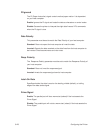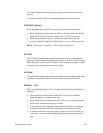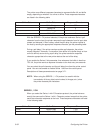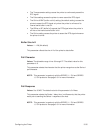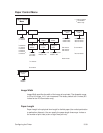
3–33Configuring the Printer
Offline Buffer Empty 0 CR
Buffer Full 2 CR
NOTE: When using the SERIES 1, 2 CH protocol, be careful with the
transmission of binary data (control codes, bit images, etc.) since
the printer discards poll characters.
DTR Protocol
The printer controls the data flow by sending this hardware signal to the host. If
there is enough room in the printer buffer, the printer will send a high signal; if the
buffer is full, the printer will send a low signal. DTR tells the host if it is safe to
send more data. (If the host sends data during an unsafe condition, data will be
lost.) DTR is not available when RS–422 is selected.
Baud Rate
Values: 600, 1200, 2400, 4800, 9600 (default), 19200, 38400, 57600, 115200
Baud.
Sets the baud rate of the serial interface in the printer. Baud rate is the speed at
which serial data is transferred between the host computer and the printer. The
choices for the RS–232 and RS–422 interfaces are 600, 1200, 2400, 4800, 9600,
19200, 38400, 57600, and 115200 Baud.
NOTE: If you select a baud rate that is greater than 19200, you will need to
use RS–422 to prevent data loss.
Word Length
Values: 7 or 8 (default) bits
Sets the length of the serial data word. The length of the data word can be set to
7 or 8 bits, and must match the corresponding data bits setting in the host
computer.
Stop Bits
Values: 1 (default) or 2.
This parameter must be set to match your host computer.






